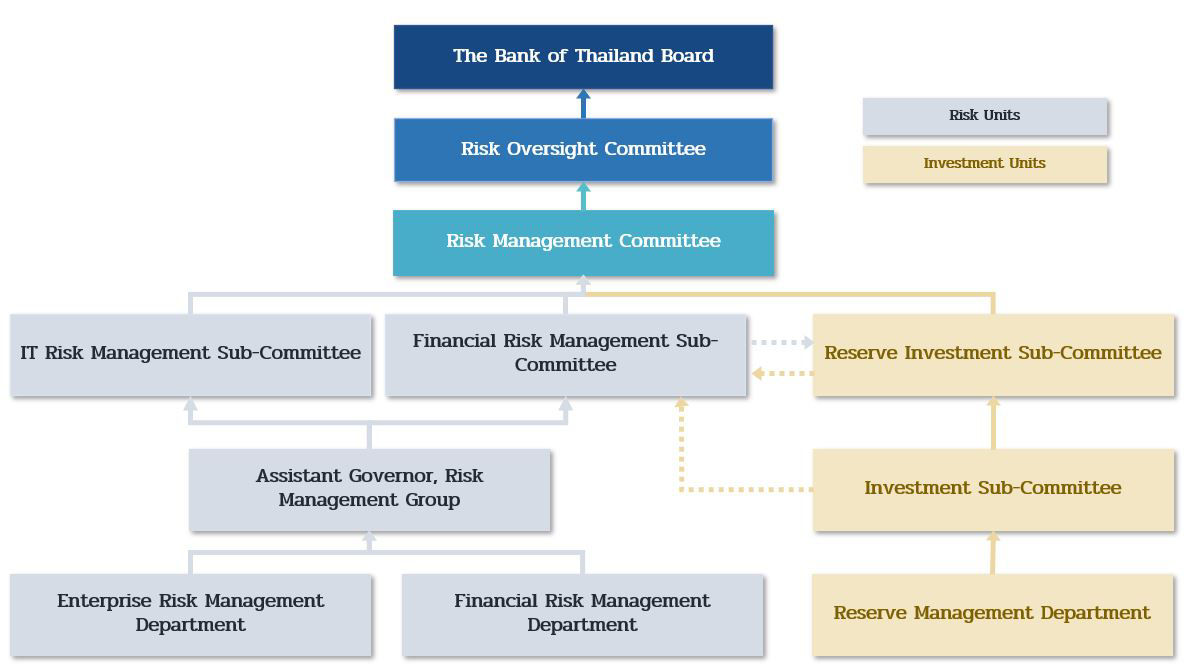Legislation
The main laws and regulations governing the BOT's reserve management are as follow:
1. Bank of Thailand ACT B.E. 2485
Section 35 The BOT shall have powers and duties to manage the BOT’s assets; including to make an investment for the purpose of earning income in accordance with the rules prescribed by the BOT Board, provided that consideration shall be taken on financial security, liquidity, income and risk management.
Section 36. For the management under Section 35, in case of the investment in foreign assets, only the following assets shall be eligible;
1. gold;
2. currency of a country accepting the obligations prescribed in Chapter 8 on Agreement on the International Monetary Fund, which must be in the form of deposits with a commercial bank outside the Kingdom, a foreign financial institution outside the Kingdom, an international financial institution, or in the form of money deposits at a custodian outside the Kingdom, in accordance with the characteristics or qualifications prescribed by the BOT Board;
3. foreign securities payable in foreign currency as stated in (2), only the following securities;
3.1 securities of a foreign government, an organization of a foreign government, an international financial institution or international organization
3.2 securities which guaranteed as to the performance of obligations by a foreign government, an international financial institution or international organization;
3.3 instruments issued by an international financial institution, of which Thailand is a member, as evidence that the holder thereof is participating with such institution in making available loans to member government or organizations of member governments of the said institution to the amount indicated in the instruments;
3.4 securities issued by other foreign organization or juristic person as prescribed by the BOT Board;
4. unit trust or foreign equity issued by a foreign entity in accordance with the rules, procedures and conditions prescribed by the BOT Board, including the determination of appropriate investment proportions of such unit trust or foreign equity.
5. right to purchase reserve tranche under the law on authorization on the operation in relevant to the International Monetary Fund and the international banks;
6. Special Drawing Right under the law on Authorization and Regulation of Certain Operation concerning Special Drawing Right in the International Monetary Fund;
7. other assets paid as subscription to the International Monetary Fund which may not be regarded as Currency Reserve under the law on currency;
8. other assets as prescribed by the BOT Board.
Section 37 The BOT shall quarterly submit the performance report on the management of the BOT’s assets to the BOT Board.
2. CURRENCY ACT B.E. 2501
Section 30. The following assets shall be lawful components of the Currency Reserve:
1. gold;
2. foreign currencies which are convertible currencies or any other currencies prescribed by a Ministerial Regulation, which must be in the form of deposit with a bank outside the Kingdom or with an international financial institution;
3. foreign securities payable in foreign currencies as stated in (2);
4. gold and foreign assets paid as subscription to the International Monetary Fund;
5. Reserve Tranche Purchase Certificate;
6. Special Drawing Right Certificate;
7. securities of the Thai Government payable in foreign currencies as stated in (2) or in baht;
8. domestic bills which the Bank of Thailand is permitted to purchase or rediscount, provided that the total value thereof does not exceed 20 per cent of the total amount of notes issued.
With respect to the assets stated in (1), (2), (3), (4), (5) and (6) above, the Bank of Thailand shall be required to maintain their total value at not less than 60 per centum of the notes issued.
